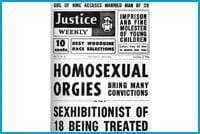“Unparalleled orgies of Perversion Exposed by Intrepid Flash Reporter: Toronto Steam Bath Uncovered as Den for Unnatural Vice!” “Simpering Creatures Dress Like Girls; Lipstick Too!”
Reading these headlines today induces ironic laughter but when they were published in the 1950s they were shocking. Tabloids may not have been respected as mainstream news but they did shape public opinion and were, horrifyingly, reflective of how “inverts” were generally perceived.
Don McLeod, a librarian at University of Toronto, first found himself at the Canadian Lesbian and Gay Archives (CLGA) almost 23 years ago while working on an AIDS bibliography. What was supposed to be a short-term contract became, upon discovering the rich trove of tabloids in the CLGA’s keeping, a long-term commitment.
McLeod says he was fascinated by the newsprint sheets’ focus on lurid same-sex crimes. Names and addresses of those found in washroom busts were published. Lives were destroyed. Being gay was not just a stigma in the ’50s, it was illegal and the punishments could be harsh.
Justice Weekly (sample headline: “Boy of 12 Victim of Nude Homosexual”) was published almost singlehandedly by Philip Daniels. Daniels maintained an office on Queen St across from City Hall. He spent his mornings in court gathering material, his afternoons as a cashier at the racetrack and his evenings writing copy to fill the daunting 16 pages required weekly.
Jim Egan, a pioneer in gay rights activism, had some success with letters to the editor in defence of homosexuals and even wrote a brief series “Aspects of Homosexuality” in the tabloid True News Times. In 1953 he pitched Daniels a series on homosexuality from, radically, the point of view of an actual invert.
“At that time I had a beard, which I have had for most of my adult life,” states Egan in Challenging the Conspiracy of Silence: My Life as a Canadian Gay Activist, which was compiled and edited by McLeod. “Daniels looked up at me as I was explaining my idea for the ‘Homosexual Concepts’ series… and said, in his best Cockney, ‘Here, what’s all this with you aping the male?’ And I asked, ‘What do you mean?’ ‘Well,’ he said, ‘you know, the beard. I didn’t think fellows like you grew beards.'”
The series Homosexual Concepts was born and the first installment hit the stands on Nov 28, 1953, credited to JLE for safety reasons. It lasted little more than a year.
The amount of influence Homosexual Concepts had may not be calculable but McLeod calls it the birth of Canadian gay media. Comparing the published articles to the carbon copies of first drafts (which Egan donated to CLGA) reveal just how much pro-homosexual theory one publisher thought the ’50s public could bear.
While the front page may have been full of hysterical condemnation many tabloids simultaneously carried gossip columns full of a different brand of hysteria. Columnists, under names like Mother Goose and Lady Bessborough, detailed the scandalous misadventures of the gay underworld. While titillating for the average reader it was one of the few ways that an invert could discover where the action was — after deciphering the campy code.

 Why you can trust Xtra
Why you can trust Xtra


